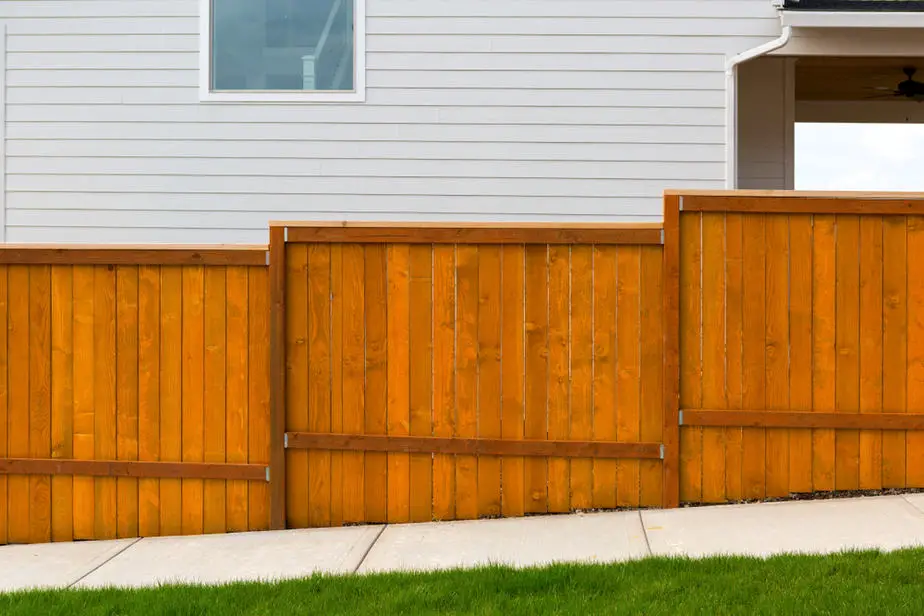Cedar is a popular choice for a wood fence in America. It is durable and long-lasting, as well as attractive. It deteriorates slowly, holds its shape well, and usually does not shrink or warp. It is relatively low-maintenance. It is weather-resistant and keeps moisture out. Its natural oils protect against insect damage and rot.

A cedar fence will usually last somewhere between 15 and 30 years.
Table of Contents
What Can I Do To Extend The Life Of My Fence?
Protect Against Moisture
To protect the fence against cracking and splintering resulting from harsh weather, put a waterproofing sealer on the cedar fence. Use a paintbrush to apply two thin coats, letting the sealer dry between coats. A sealer with built-in UV protection can also provide the fence a sun-barrier in hot conditions.
Reseal the fence every three to five years.
To minimize the fence’s risk of rotting or growing moss, ensure that your garden sprinklers are not placed close to the fence.
If the ground in which your fence posts sit is moisture-laden, their useful life can be reduced by up to three years. Ensure they are stained or treated before installation. A concrete or gravel filler for the post holes is essential to keep moisture out.
Care Around Fences
Insects can become a nuisance for your fence, so keep the fenced area clear of debris and piles of leaves that can house pests.
Cut back bushes and vines which are hanging on the fence. They can retain moisture and may drag on your fence.
Check for proper drainage around your fence, as you do not want water piling up by the fence posts. Excess water can cause your fence to deteriorate.
Ensure the soil at the base of the fence posts is packed down well and slopes away from the fence.
Repair Your Fence
Every year, check to see if your fence has any rot or is damaged. If boards are broken, you need to replace them. You should tighten screws or hammer down loose nails as required. Check to see if any parts of your fence are leaning. If so, make sure the fence posts are secure in the ground or replace them.
Clean Your Fence
You should clean your cedar fence regularly, ideally every year. Remove any moss, mildew, and dirt. Scrub any tough stains from the fence.
You can remove mold or mildew by spraying the fence with a bleach/mild detergent solution and then washing it after about an hour. This helps to kill mold spores so that they do not grow back again and cause your fence to rot.
After cleaning, washing, and rinsing, recoat your fence with a water-repellant protective coating, preferably containing UV protection.
Do I Need To Treat My Cedar Fence?
The lovely red color of a cedar wood fence will fade to gray unless you treat your fence. A treated wood fence can last longer than an untreated one. Treating your fence could increase your fence’s life from 20 years to 40 years.
You can use a bleaching oil, a semi-transparent stain, solid color stain, or primer and paint.
Let’s take a look at the differences:
- Bleaching Oil – about three to six months after application, this results in a gray, weathered, naturally aged appearance, and offers moisture protection.
- Semi-Transparent Stain – will produce a slightly weathered look – less weathered than with bleaching oil – and offers wood protection from moisture.
- Solid Color Stain – this results in an opaque color that will still allow some of the cedar’s natural grain to come through. It provides good UV and moisture protection.
- Primer and Paint – If your main goal is to protect your fence from light – which causes wood fences to deteriorate – this is a good option. Make sure you prime the fence before painting because cedar has large pores.
Is A Cedar Fence Better Than Pine?
Cedar and pine are two of the most common materials used in fences. There are differences to consider when choosing between them.
- Appearance – cedar has a red color and is a warm looking wood. Pine is much lighter colored, with cream or light brown tones.
- Cost – pine is cheaper than cedar. Pine costs somewhere between $10 to $20 per linear foot. While cedar, considered more attractive and durable, is $20-$35 per linear foot. Prices may vary depending on where you live and the availability of stock.
- Useful Life – pine fences last around 10-15 years, while cedar fences usually last well over 20 years.
- Climate – cedar does very well in dry climates, while humid and wet climates can cause the wood to expand, causing problems for your fence. Pine does better in humid climates.
- Smell – cedar has a lovely fragrance which many people appreciate. Pine has very little odor.
Final Thoughts
After all is said and done, the length of time your cedar fence lasts really comes down to how well you take care of it throughout the years. Be sure to clean, repair, and check for damage often, and apply a protective coat to prevent wear.